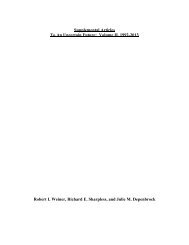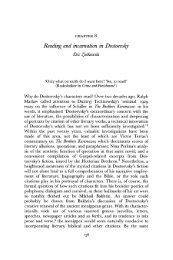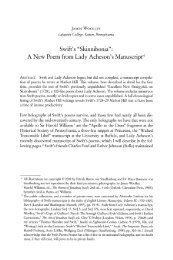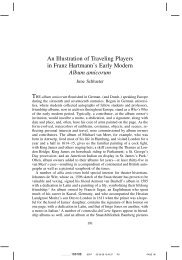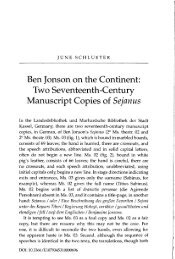courses of instruction - Lafayette College
courses of instruction - Lafayette College
courses of instruction - Lafayette College
You also want an ePaper? Increase the reach of your titles
YUMPU automatically turns print PDFs into web optimized ePapers that Google loves.
BIOLOGY<br />
121-122. Lecture/laboratory. Offered in<br />
spring semester. Ms. Caslake, Ms. Schoeneck<br />
271. Marine Biology. An introductory<br />
study <strong>of</strong> the natural history, physiology,<br />
and ecological relationships <strong>of</strong> marine<br />
plants and animals. Major emphasis is<br />
placed on plant and animal adaptations to<br />
marine environments, factors influencing<br />
primary production, food webs, fisheries,<br />
and the effects <strong>of</strong> marine pollution. In ad<br />
dition to the lectures, a film is presented<br />
each week. Prerequisite: Biology 101-102,<br />
or permission <strong>of</strong> instructor. Lecture/film.<br />
Offered in spring semester. Mr. Holliday<br />
302. Biological Electron Microscopy.<br />
This course introduces students to the re<br />
cent advances in transmission and scan<br />
ning electron microscopy, cryoultramicrot-<br />
omy, freeze fracturing, autoradiography,<br />
and immunoelectron microscopy. In the<br />
laboratory, students learn the use <strong>of</strong> both<br />
the transmission and scanning electron<br />
microscopes and ultramicrotomy, includ<br />
ing the use <strong>of</strong> the critical point drying ap<br />
paratus and sputterer-coaters. Additional<br />
ly, students carry out two out-<strong>of</strong>-class<br />
mini-research projects and present oral<br />
and written reports at intervals over the<br />
semester. Prerequisites: Biology 101-102,<br />
and permission <strong>of</strong> instructor. Lecture/lab<br />
oratory/discussion/independent labora<br />
tory. Offered in spring or fall semester.<br />
[W] Mr. Majumdar<br />
304. Tissue Culture and Virology. An in<br />
troduction to the theories, principles, and<br />
evaluations <strong>of</strong> the latest techniques em<br />
ployed in tissue culture and virology.<br />
Laboratory work stresses experimental<br />
procedures and designs used in the cultur-<br />
ing, handling, and study <strong>of</strong> animal cells.<br />
Additionally, students carry out one or<br />
more independent research projects. Pre<br />
requisites: Biology 101-102, and permis<br />
sion <strong>of</strong> instructor. Mr. Majumdar<br />
306. Biology <strong>of</strong> Parasites. A course de<br />
signed to familiarize students with repre<br />
sentative animal parasites by studying<br />
their morphology, ecology, physiology,<br />
biochemistry, and host-parasite relation<br />
70<br />
ships. Basic laboratory exercises acquaint<br />
students with techniques prior to assign<br />
ment <strong>of</strong> individual problems dealing with<br />
selected parasites. In addition to lecture and<br />
laboratory examinations, students are re<br />
quired to present written or oral reports on<br />
selected articles from the current periodical<br />
literature. Prerequisites: Biology 201 and<br />
permission <strong>of</strong> instructor. Lecture/seminar/<br />
laboratory. Offered in spring semester.<br />
Hours by arrangement. [S] Mr. Fried<br />
308. Comparative Animal Physiology. In<br />
this advanced course, animal species are<br />
treated as variables in the study <strong>of</strong> the di<br />
versity <strong>of</strong> adaptations to physiological<br />
problems presented by the environment<br />
(e.g., salt and water balance, temperature<br />
regulation, circulation, respiration). Labo<br />
ratory work stresses experimental design<br />
and independent study. Prerequisites: Bi<br />
ology 251, and permission <strong>of</strong> instructor.<br />
Lecture/laboratory. Offered in spring se<br />
mester. Mr. Holliday<br />
312. Cell Biology. This course covers<br />
structure, function, and chemistry <strong>of</strong> cells,<br />
organelles, and membranes. Specific top<br />
ics include cellular energetics, information<br />
flow in cells, cytoskeletal structure and<br />
functions, signal transduction mechanisms<br />
and cellular aspects <strong>of</strong> the immune re<br />
sponse, and cancer. Students read selected<br />
topics <strong>of</strong> current importance in cell biology<br />
and present oral and written reports. Pre<br />
requisites: Biology 101-102, and permission<br />
<strong>of</strong> instructor. Lecture/seminar/discus<br />
sion/computer simulation. Offered in<br />
spring or fall semester. [S] Mr. Majumdar<br />
314. Advanced Anatomy. An exploration<br />
<strong>of</strong> the conceptual approaches and modern<br />
experimental techniques used in function<br />
al morphology. Through a combination <strong>of</strong><br />
anatomy, physiology, and biomechanics,<br />
students explore the functional basis <strong>of</strong> lo<br />
comotion and feeding in vertebrate ani<br />
mals. Prerequisites: Biology 211 or 213 or<br />
251. Lecture/seminar/laboratory. Offered<br />
in spring semester. [S] Mr. Young<br />
332. Limnology. Students develop ad<br />
vanced knowledge <strong>of</strong> freshwater ecosys-



